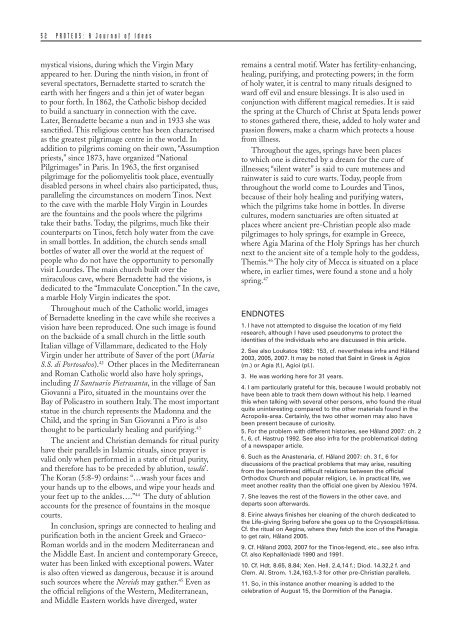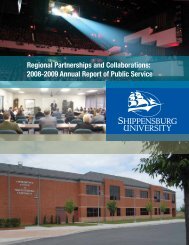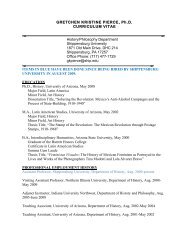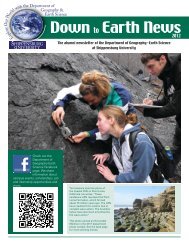Complete Issue - Shippensburg University
Complete Issue - Shippensburg University
Complete Issue - Shippensburg University
- No tags were found...
Create successful ePaper yourself
Turn your PDF publications into a flip-book with our unique Google optimized e-Paper software.
52 PROTEUS: A Journal of Ideasmystical visions, during which the Virgin Maryappeared to her. During the ninth vision, in front ofseveral spectators, Bernadette started to scratch theearth with her fingers and a thin jet of water beganto pour forth. In 1862, the Catholic bishop decidedto build a sanctuary in connection with the cave.Later, Bernadette became a nun and in 1933 she wassanctified. This religious centre has been characterisedas the greatest pilgrimage centre in the world. Inaddition to pilgrims coming on their own, “Assumptionpriests,” since 1873, have organized “NationalPilgrimages” in Paris. In 1963, the first organisedpilgrimage for the poliomyelitis took place, eventuallydisabled persons in wheel chairs also participated, thus,paralleling the circumstances on modern Tinos. Nextto the cave with the marble Holy Virgin in Lourdesare the fountains and the pools where the pilgrimstake their baths. Today, the pilgrims, much like theircounterparts on Tinos, fetch holy water from the cavein small bottles. In addition, the church sends smallbottles of water all over the world at the request ofpeople who do not have the opportunity to personallyvisit Lourdes. The main church built over themiraculous cave, where Bernadette had the visions, isdedicated to the “Immaculate Conception.” In the cave,a marble Holy Virgin indicates the spot.Throughout much of the Catholic world, imagesof Bernadette kneeling in the cave while she receives avision have been reproduced. One such image is foundon the backside of a small church in the little southItalian village of Villammare, dedicated to the HolyVirgin under her attribute of Saver of the port (MariaS.S. di Portosalvo). 42 Other places in the Mediterraneanand Roman Catholic world also have holy springs,including Il Santuario Pietrasanta, in the village of SanGiovanni a Piro, situated in the mountains over theBay of Policastro in southern Italy. The most importantstatue in the church represents the Madonna and theChild, and the spring in San Giovanni a Piro is alsothought to be particularly healing and purifying. 43The ancient and Christian demands for ritual purityhave their parallels in Islamic rituals, since prayer isvalid only when performed in a state of ritual purity,and therefore has to be preceded by ablution, wudû’.The Koran (5:8-9) ordains: “…wash your faces andyour hands up to the elbows, and wipe your heads andyour feet up to the ankles….” 44 The duty of ablutionaccounts for the presence of fountains in the mosquecourts.In conclusion, springs are connected to healing andpurification both in the ancient Greek and Graeco-Roman worlds and in the modern Mediterranean andthe Middle East. In ancient and contemporary Greece,water has been linked with exceptional powers. Wateris also often viewed as dangerous, because it is aroundsuch sources where the Nereids may gather. 45 Even asthe official religions of the Western, Mediterranean,and Middle Eastern worlds have diverged, waterremains a central motif. Water has fertility-enhancing,healing, purifying, and protecting powers; in the formof holy water, it is central to many rituals designed toward off evil and ensure blessings. It is also used inconjunction with different magical remedies. It is saidthe spring at the Church of Christ at Spata lends powerto stones gathered there, these, added to holy water andpassion flowers, make a charm which protects a housefrom illness.Throughout the ages, springs have been placesto which one is directed by a dream for the cure ofillnesses; “silent water” is said to cure muteness andrainwater is said to cure warts. Today, people fromthroughout the world come to Lourdes and Tinos,because of their holy healing and purifying waters,which the pilgrims take home in bottles. In diversecultures, modern sanctuaries are often situated atplaces where ancient pre-Christian people also madepilgrimages to holy springs, for example in Greece,where Agia Marina of the Holy Springs has her churchnext to the ancient site of a temple holy to the goddess,Themis. 46 The holy city of Mecca is situated on a placewhere, in earlier times, were found a stone and a holyspring. 47ENDNOTES1. I have not attempted to disguise the location of my fieldresearch, although I have used pseudonyms to protect theidentities of the individuals who are discussed in this article.2. See also Loukatos 1982: 153, cf. nevertheless infra and Håland2003, 2005, 2007. It may be noted that Saint in Greek is Agios(m.) or Agia (f.), Agioi (pl.).3. He was working here for 31 years.4. I am particularly grateful for this, because I would probably nothave been able to track them down without his help. I learnedthis when talking with several other persons, who found the ritualquite uninteresting compared to the other materials found in theAcropolis-area. Certainly, the two other women may also havebeen present because of curiosity.5. For the problem with different histories, see Håland 2007: ch. 2f., 6, cf. Hastrup 1992. See also infra for the problematical datingof a newspaper article.6. Such as the Anastenaria, cf. Håland 2007: ch. 3 f., 6 fordiscussions of the practical problems that may arise, resultingfrom the (sometimes) difficult relations between the officialOrthodox Church and popular religion, i.e. in practical life, wemeet another reality than the official one given by Alexiou 1974.7. She leaves the rest of the flowers in the other cave, anddeparts soon afterwards.8. Eirinē always finishes her cleaning of the church dedicated tothe Life-giving Spring before she goes up to the Crysospēliōtissa.Cf. the ritual on Aegina, where they fetch the icon of the Panagiato get rain, Håland 2005.9. Cf. Håland 2003, 2007 for the Tinos-legend, etc., see also infra.Cf. also Kephallēniadē 1990 and 1991.10. Cf. Hdt. 8.65, 8.84; Xen. Hell. 2.4,14 f.; Diod. 14.32,2 f. andClem. Al. Strom. 1.24,163,1-3 for other pre-Christian parallels.11. So, in this instance another meaning is added to thecelebration of August 15, the Dormition of the Panagia.
















